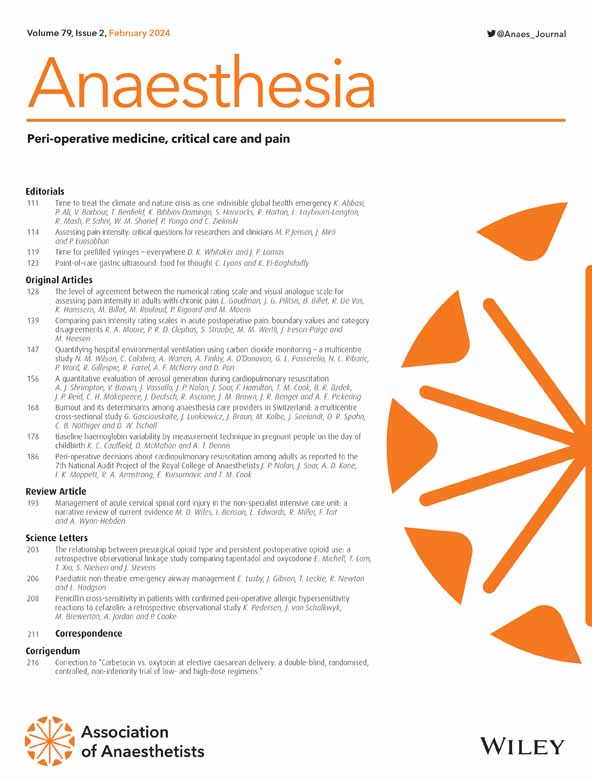分娩人群对一氧化二氮用于分娩镇痛的环境和职业暴露风险的看法:一项基于访谈的定性研究。
IF 6.9
1区 医学
Q1 ANESTHESIOLOGY
引用次数: 0
摘要
在英国,50:50的氧化亚氮/氧气混合物通常用于分娩镇痛;然而,如果不采取适当措施,一氧化二氮对环境的影响相对较高,工作人员有潜在的接触风险。要按照净零排放目标减少一氧化二氮的影响,就需要广泛改变一氧化二氮的施用方式或提供分娩镇痛的替代方案。本定性研究的目的是在对环境和职业接触的关切背景下,从产妇的角度了解一氧化二氮的使用情况,并提供证据,指导制定以患者为中心的一氧化二氮缓解战略。方法:我们对使用氧化亚氮分娩镇痛的患者进行了半结构化访谈。参与者是有目的招募的。数据分析采用反身性主题分析。结果:我们进行了12次访谈,确定了三个主题:一氧化二氮是英国分娩镇痛的默认使用;减轻一氧化二氮的危害取决于个人的优先事项;机构有责任减轻一氧化二氮的危害。参与者认为一氧化二氮是一种安全的选择,在有限的分娩镇痛选择的背景下随时可用。他们会有兴趣了解一氧化二氮的环境风险,尽管这并不一定会影响他们使用它的选择。他们对它的职业风险不太感兴趣,认为机构而不是劳动中的个人有责任减轻这些风险。虽然他们认为投资减少国民保健制度的排放很重要,但与会者也认为可能有其他更紧迫的财政优先事项。本研究为支持制定减少氧化亚氮排放的策略提供了证据,该策略考虑了使用氧化亚氮进行分娩镇痛的人的观点。本文章由计算机程序翻译,如有差异,请以英文原文为准。
Views of people who have given birth on the environmental and occupational exposure risks of nitrous oxide for labour analgesia: an interview-based qualitative study.
INTRODUCTION
A 50:50 nitrous oxide/oxygen mix is commonly used for labour analgesia in the UK; however, nitrous oxide is associated with comparatively high environmental impact and potential exposure risks to staff if appropriate measures are not taken. Reduction of the impact of nitrous oxide in line with net zero emissions targets would require widespread changes in the way nitrous oxide is administered or in the availability of alternative options for labour analgesia. The aims of this qualitative study were to understand nitrous oxide use from the perspective of the parturient in the context of concerns regarding the environment and occupational exposure, and to provide evidence to guide the development of patient-centred nitrous oxide mitigation strategies.
METHODS
We conducted semi-structured interviews with participants who had used nitrous oxide for labour analgesia. Participants were recruited purposively. Data were analysed using reflexive thematic analysis.
RESULTS
We conducted 12 interviews and identified three themes: nitrous oxide is the default for labour analgesia in the UK; mitigating nitrous oxide harm depends on personal priorities; and institutions have a responsibility to mitigate nitrous oxide harm. Participants viewed nitrous oxide as a safe option, readily available in the context of limited choices for labour analgesia. They would be interested to know about the environmental risk of nitrous oxide, though this would not necessarily influence their choice to use it. They were less interested in its occupational risks and considered institutions, rather than individuals in labour, to have a responsibility to mitigate these. Though they felt that investment in reducing NHS emissions is important, participants also felt there may be other more pressing financial priorities.
DISCUSSION
This study provides evidence to support the development of strategies to reduce nitrous oxide emissions, which consider the views of people who have used nitrous oxide for labour analgesia.
求助全文
通过发布文献求助,成功后即可免费获取论文全文。
去求助
来源期刊

Anaesthesia
医学-麻醉学
CiteScore
21.20
自引率
9.30%
发文量
300
审稿时长
6 months
期刊介绍:
The official journal of the Association of Anaesthetists is Anaesthesia. It is a comprehensive international publication that covers a wide range of topics. The journal focuses on general and regional anaesthesia, as well as intensive care and pain therapy. It includes original articles that have undergone peer review, covering all aspects of these fields, including research on equipment.
 求助内容:
求助内容: 应助结果提醒方式:
应助结果提醒方式:


